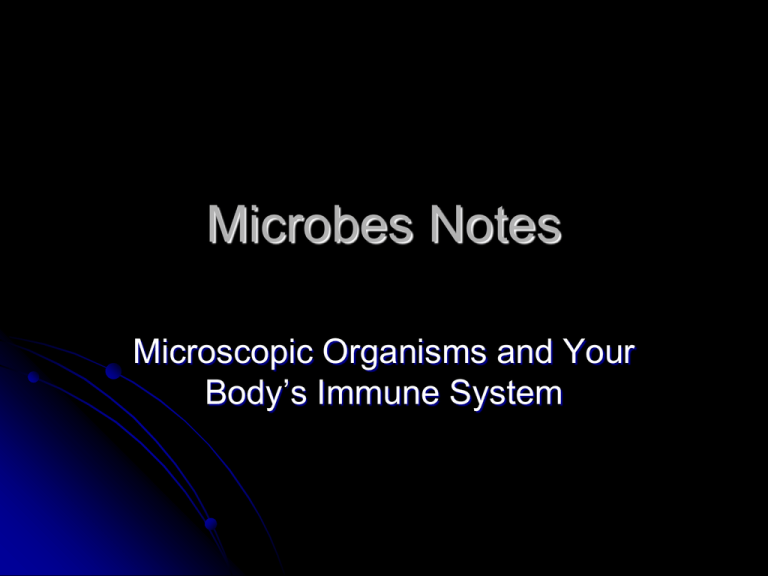Ch 11 & 12 Notes
advertisement

Microbes Notes Microscopic Organisms and Your Body’s Immune System What is a microbe? Microbe: A microscopic organism that has the potential to cause disease. 4 Categories: Virus Bacteria Protist Fungus What is a virus? A tiny nonliving particle that enters and then reproduces inside a living cell. Viruses can only reproduce inside a living cell. Viruses take on many shapes from rod, round, bricks, threads, bullets, and even robot like shapes. Viruses have two basic parts: A protein coat that protects the virus An inner core made of genetic material How do viruses multiply? 1. Virus attaches to a host cell. 2. Virus enters the host cell in a vesicle through endocytosis. 3. The virus DNA is copied by the host cell. 4. New viruses form inside the host cell. 5. New viruses are released to the body via exocytosis. What is bacteria? Bacteria are single celled organisms. They are prokaryotes: Bacteria take one of three shapes: meaning their genetic material in the cell is not contained in a nucleus. spherical, rodlike, or spiral. Bacteria reproduce one of two ways; asexually (involves only one parent) by binary fission sexually (involves two parents) by conjugation. What does bacteria look like? Draw and label this diagram into your notes. What are the two kingdoms of bacteria? Eubacteria - Larger of the two kingdoms and very common. - Producer Eubacteria: - - Make their own food through photosynthesis. Consumer Eubacteria Archeabacteria - Smaller of the two kingdoms and found in the most extreme conditions. ( ex. Hot springs, Dead Sea, Great Salt Lake) - Archeabacteria are used in sewage treatment plants. Bacteria in Your Life - - We cannot live without bacteria. Good Guys: - - - - - Antibiotics: - A chemical produces by some bacteria that limits the growth of other harmful bacteria. - Examples: - Bacillus: Used in antiseptic ointment. Saprophytes: - Bacteria that uses dead organism as their food source - Used in sewage treatment plants. Food: - Examples: - Yogurt, Cheese, Vinegar, Pickles, Olives, Soy Sauce, etc. Industry: - Cleaning supplies, methane gas energy, etc. Bad Guys: - The bad guys cause disease and are known as pathogens. Example: Streptococcus- Causes strep throat How viruses and bacteria affect your health? Bacteria and viruses are known as infectious diseases when they enter your body and make you sick. (spread by contact with an infected person, object, animal, or source) Bacteria can be treated with antibiotics (remember that it also kills the good bacteria inside your body). Viruses can’t be treated with antibiotics, rather you are given a weakened strand of the virus known as a vaccine and your body builds its own treatment to the virus. What is a protist? Protist are eukaryotes (have a nucleus) that can be classified as animals, plants, or fungi. What are the types of Protists? Three major types of protist Animal-like protist are able to move from place to place (ex: amoeba and paramecium) Animal like protist are categorized by the way they move: pseudopods, cilia, flagella, or parasites. Plantlike protist usually don’t move. (ex: algae, diatoms, dinoflagellates, and euglenoids) There are six types of plantlike protists. They are diatoms, dinoflagellates, euglenoids, red algae, green algae, and brown algae. Funguslike protist have cell walls, and use spores to reproduce. The three types of funguslike protists are slime molds, water molds, and downy mildews. What are fungi? Fungi have both characteristics of a plant and animal. They are eukaryotes that have cell walls, are heterotrophs that feed by absorbing their food, and use spores to reproduce. Fungi play important roles as decomposers and recyclers on Earth, they are food, and are used to fight diseases. What are pathogens? Pathogens are organisms that cause a disease. Pathogens are spread through contact with an infected person, object, or animal; or by soil, food, or water. Four types of pathogens are Bacteria Viruses Fungi Protists How does the body fight off pathogens? The body has three lines of defense against pathogens. First line of defense is the skin, breathing passages, and stomach. They act as a barrier to pathogens, keeping them out or trapping and killing the pathogen. Second line of defense is the inflammatory response. Here the body responds with fluid and white blood cells. White blood cells leak from the blood into the tissue and fight off the pathogens. Immune system continued Third line of defense is the immune response where the cells of the immune system can distinguish between different types of pathogens. T-cells are sent out to identify the pathogen (take a picture) B-cells produce the protein to fight off the pathogen (build proteins)









